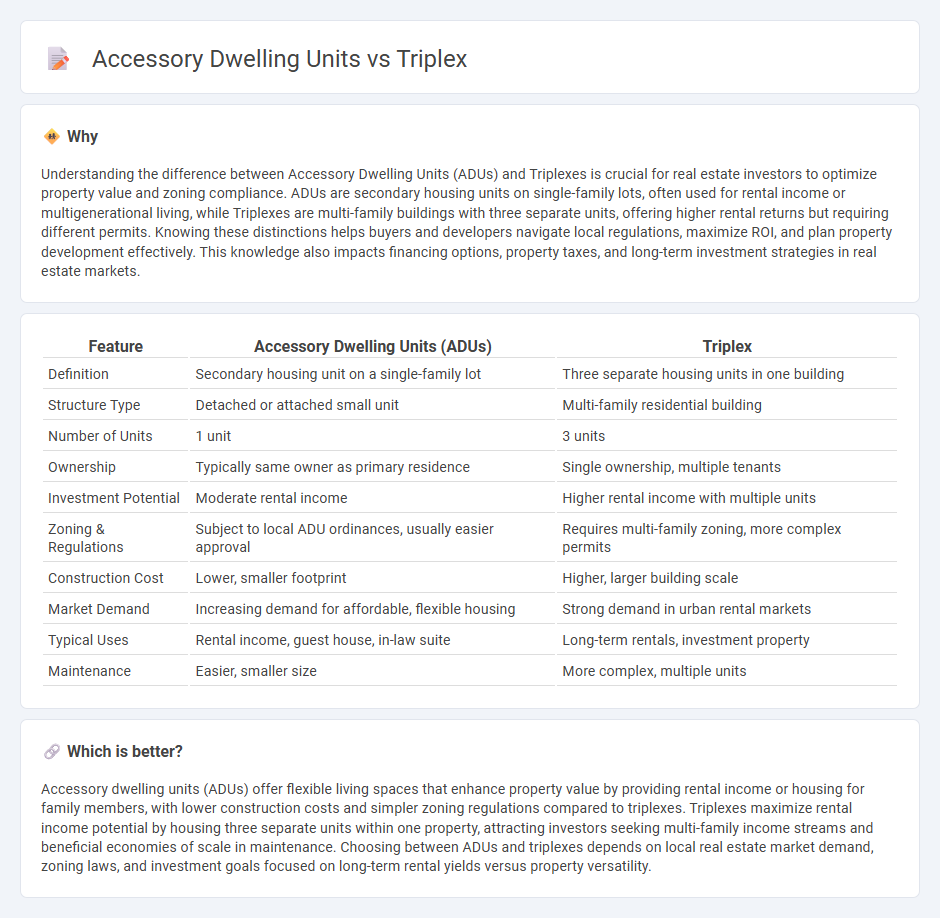
Accessory dwelling units (ADUs) are secondary housing units on a single-family residential lot, offering flexible space for rental income or multigenerational living. Triplexes are multi-family buildings with three separate dwelling units designed for independent occupancy, maximizing rental potential on one property. Explore the key differences and benefits of ADUs versus triplexes to determine the best investment strategy.
Why it is important
Understanding the difference between Accessory Dwelling Units (ADUs) and Triplexes is crucial for real estate investors to optimize property value and zoning compliance. ADUs are secondary housing units on single-family lots, often used for rental income or multigenerational living, while Triplexes are multi-family buildings with three separate units, offering higher rental returns but requiring different permits. Knowing these distinctions helps buyers and developers navigate local regulations, maximize ROI, and plan property development effectively. This knowledge also impacts financing options, property taxes, and long-term investment strategies in real estate markets.
Comparison Table
| Feature | Accessory Dwelling Units (ADUs) | Triplex |
|---|---|---|
| Definition | Secondary housing unit on a single-family lot | Three separate housing units in one building |
| Structure Type | Detached or attached small unit | Multi-family residential building |
| Number of Units | 1 unit | 3 units |
| Ownership | Typically same owner as primary residence | Single ownership, multiple tenants |
| Investment Potential | Moderate rental income | Higher rental income with multiple units |
| Zoning & Regulations | Subject to local ADU ordinances, usually easier approval | Requires multi-family zoning, more complex permits |
| Construction Cost | Lower, smaller footprint | Higher, larger building scale |
| Market Demand | Increasing demand for affordable, flexible housing | Strong demand in urban rental markets |
| Typical Uses | Rental income, guest house, in-law suite | Long-term rentals, investment property |
| Maintenance | Easier, smaller size | More complex, multiple units |
Which is better?
Accessory dwelling units (ADUs) offer flexible living spaces that enhance property value by providing rental income or housing for family members, with lower construction costs and simpler zoning regulations compared to triplexes. Triplexes maximize rental income potential by housing three separate units within one property, attracting investors seeking multi-family income streams and beneficial economies of scale in maintenance. Choosing between ADUs and triplexes depends on local real estate market demand, zoning laws, and investment goals focused on long-term rental yields versus property versatility.
Connection
Accessory dwelling units (ADUs) and triplex properties both enhance residential density by offering multiple living spaces within a single parcel of land, maximizing housing options. ADUs provide secondary living quarters on the same lot as a primary residence, while triplexes consist of three separate units in one building, facilitating investment diversification and affordable housing. Both strategies support urban infill development and regulatory incentives aimed at addressing housing shortages in metropolitan areas.
Key Terms
Zoning Regulations
Triplex zoning regulations typically permit three separate dwelling units on a single lot, often in areas zoned for multi-family housing, while accessory dwelling units (ADUs) are secondary living spaces allowed on properties with a primary residence, subject to more restrictive size and occupancy limits. ADU regulations emphasize maintaining neighborhood character and may impose height, setback, and parking requirements distinct from those for triplexes. Explore detailed zoning guidelines in your municipality to understand specific allowances and restrictions for triplexes and ADUs.
Occupancy Limits
Triplexes are typically subject to standard occupancy limits based on the number of bedrooms and local housing codes, often allowing one family per unit with restrictions on the total occupants per room. Accessory Dwelling Units (ADUs) usually face stricter occupancy limits tied to the primary dwelling's size and zoning regulations, often restricting the number of residents to ensure neighborhood compatibility. Explore detailed municipal codes and regulations to understand how occupancy limits impact the design and use of triplexes versus ADUs in your area.
Property Value
Triplex properties typically offer higher rental income potential and greater overall property value due to multiple separate living units, attracting investors focused on maximizing returns. Accessory dwelling units (ADUs) enhance single-family homes' value by providing additional rentable space without the need for acquiring separate properties, appealing to homeowners seeking flexibility and increased equity. Explore how triplexes and ADUs impact property valuation to determine the best investment strategy for your real estate goals.
Source and External Links
What Is a Triplex? - REtipster - A triplex is a residential building with three separate units, often used for investment and rental income.
What Is A Triplex | Definition & Examples - DoorLoop - A triplex brings together three residential units into one structure, each with its own amenities and separate entrances.
What Is a Triplex, and Is It a Better Investment Than a Duplex? - Azibo - Triplexes are residential buildings divided into three separate living units, each with its own entrance and amenities like kitchens and bathrooms.
 dowidth.com
dowidth.com